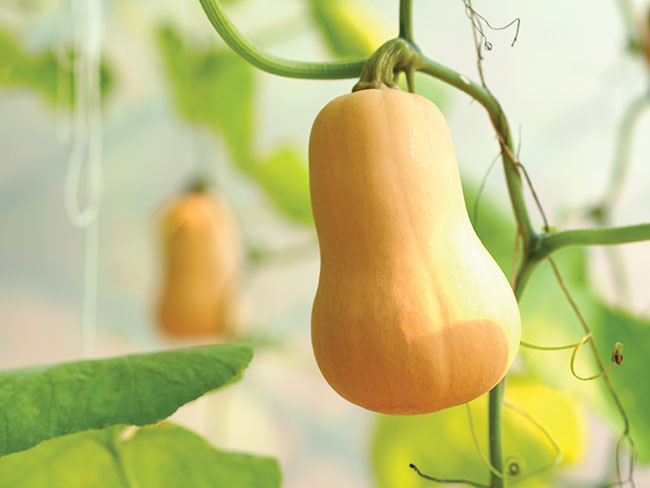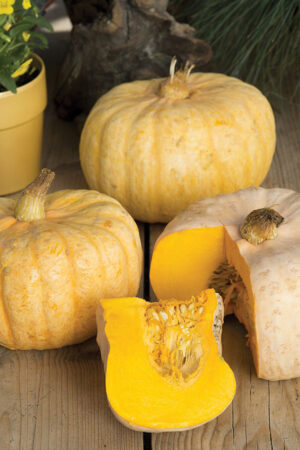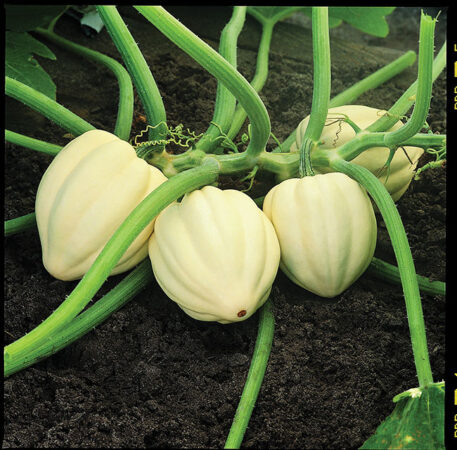
Features
2024 is the YEAR of the squash
Reflects rising interest in home and culinary gardening
February 12, 2024 By Diane Blazek
 Photo: © Pada smith / iStock / Getty Images Plus
Photo: © Pada smith / iStock / Getty Images Plus Every year, National Garden Bureau decides which crops to highlight in our “Year of” program. We select plant classes that are popular, or gaining in popularity, are easy to grow and have had some interesting new breeding work of late.
For 2024, we chose squash in the edible category because of the rising interest in home gardening and specifically, culinary gardening. The basic varieties always continue to sell but more and more new gardeners like to grow something unique that is also healthy to consume. Many squash varieties certainly fit that bill! Even better, many squash can be grown for decorative purposes as well.
A few varieties of Summer Squash to note:
Sunburst F1 – A pattypan or scalloped type known for its earliness and productivity. Can be harvested at two-to-three inches as a baby squash or grown larger. A buttery flavour makes this perfect for stir fry.
Eight Ball F1 – The first dark green round, zucchini squash. Easy to grow, the baby squash is ready about five-to-six weeks after planting. Leave the ball to get larger and use it as a bowl.
Easy Pick Gold II – A parthenocarpic golden zucchini that doesn’t need bees for pollination! An open habit and nearly spineless make it easy to harvest without pain and less scaring on the fruit.
Spineless Perfection – An improvement on Spineless Beauty with the addition of powdery mildew and virus resistances. Produces attractive, high-gloss fruit on open, truly spineless, upright plants.
Bossa Nova F1 – The beautiful dark and light green mottled exterior of this zucchini sets it apart and makes the fruits easier to see during a long and prolific harvest. Smooth flesh texture and sweet, mild taste.
Black Beauty – This early and prolific variety has been exceedingly popular for its very dark green skin and creamy white flesh. Fast-growing plants will produce abundantly all summer long if picked continuously.
Early Prolific Straightneck – An early, prolific straight neck summer squash that produces creamy yellow, tender fruit early in the season.

The rise in popularity of culinary gardening helped pave the way for squash to be named 2024’s ‘Year of…’ edible plant.
Photo: National Garden Bureau
A few varieties of Winter Squash to note:
Sweet Jade F1 – A cute, single-serving-sized kabocha type. Sweet, earthy, and nutritious, the high-yielding plants produce one-to-two-pound fruits.
Bush Delicata – Also known as Sweet potato squash, Bush Delicata is so sweet itself that butter and brown sugar are optional. The sweet flesh is fine textured without coarse strings. Skin is edible.
Sugaretti F1 – A spaghetti winter squash produced on semi-bush vines that spread only about 2 feet wide/long. Making it perfect for small urban gardens. The nutty sweet flesh can be used as a pasta substitute. Hard shells protect the flesh for a long shelf life.
Honey Bear F1 – A flavourful and sweet, high-yielding acorn squash that tolerates cool, moist temperatures and continues to ripen squash while other varieties succumb to mildew. Compact, bush habit.
Goldilocks F1 – A golden orange acorn squash that has high yields, disease tolerance, and a sweet, rich nutty flavor. Vigorous plants produce 10+ fruits each weighing about 1 pound.
Waltham Butternut – It has a hard, yellow-to-tan exterior with a deliciously sweet, orange flesh inside. Exceptional quality, no stringiness. This long-lasting squash stores all winter.
Bonbon –Has an upright, semi-bush habit needing less garden space. The squash has thick orange flesh and, when cooked, delivers a sweet flavour (hence the name Bonbon) and creamy texture.
Tips for Growing Squash:
1. Sowing Seeds
- Direct sow into the garden once soil temperatures are above 65oF. Germination will not occur if soil temperatures are below 60oF.
- Avoid the temptation to sow too early as squash are a warm-season crop. Raised beds and mulch will help keep the roots warm.
- Seed Depth: 1/2 – 1 inch
- Days to maturity: Usually shown for direct sow. Subtract two weeks if transplanting.
2. Summer Squash Growing Tips:
- Plant Spacing: 12-24” (read labels for specifics on your variety)
- Row Spacing: 5-6 feet
- Harvest: Most summer squash has the best fruit quality when harvested at 5-8” or smaller. Some varieties are suitable as baby vegetables. Frequent harvesting will keep the plant productive. Squash will increase in size rapidly. Inspect plants frequently for harvestable fruit.
- Storage: Summer squash is very perishable. Store in the refrigerator for 3-4 days.
3. Winter Squash Growing Tips:
- Plant Spacing: Bush types: 18-24”; Vining types: 24-36”
- Row Spacing: Bush, semi-bush, and short vine types: 6 feet; Vigorous vining types: 9 feet.
- Harvest indicator: Fruits are full-sized, have a deep rich color, and hard rinds that can’t be dented easily with a fingernail. Another indicator is that the ‘ground spot’ changes color from yellow to cream, gold, or orange
- Harvest and Curing: cut the stem at least 2”-4” from the fruit. A short or broken stem can lead to rot. Cure after harvest by keeping in a warm (80-90F), dry location for a few days. Curing time will be dependent on the type. Delicata and Acorn squash do not need curing but will not store as long as other types. Gently wash in a sanitizing solution such as 10 parts water to 1 part bleach.
- Storage: Store at 50-60F with 50-75% humidity and good air circulation.
4. Pollination:
Squash requires bees to move pollen from the male to the female flowers.
- A monoecious plant, squash can produce male and female blooms, and both produce nectar which attracts the bees.
- Male blooms are borne on long, narrow stems.
- Female blooms are found close to the stem of the plant.
- It takes as many as twelve visits to a female flower by pollen-laden bees to complete the pollination process.
- Timing is everything and there should be both male and female blooms open for pollination to occur.
- Incomplete pollination results in the appearance of fruits that turn from green to pale yellow and never size up.
- Oftentimes the immature fruit appears shriveled or woody.
- Remove these from the plant as soon as detected.
- Incomplete or lack of pollination can occur under windy conditions which make it difficult for the bees to move about productively or under cool, wet conditions which discourages bees from foraging.
- Planting ornamental flowers near squash can help attract bees to your vegetable garden.
- Most bees tend to fly within 30 feet of ground or tree level. If growing squash on a high balcony or rooftop, you could be out-of-range to attract bees. It may be necessary to hand-pollinate in this situation.
- 5. Common Pests and Disease Info:
- Spotted and Striped Cucumber Beetle – the use of a floating row cover can be effective in controlling cucumber beetles. Remove all crop debris to discourage overwintering populations and practice crop rotation.
- Squash Vine Borer – causes plants to look wilted even when moisture is adequate. If possible, slice open the stem, remove the borer, and destroy it.
- Squash (Stink) Bugs – feed on plant sap and fruit juices. Make sure to harvest often and remove overgrown fruit. Neem oil, Insecticidal soap, and homemade soap or coffee ground sprays work against adult squash bugs. Or if you are fast, handpick the bugs and drop them in a pail of soapy water. Crush the bronze to brick red coloured eggs found on the stems and underside of leaves. Remove old vines and leaf litter from the garden where adult squash bugs overwinter.
- Powdery Mildew – create good air circulation by providing wide spacing and eliminating weeds. Choose resistant varieties. Remove severely infected leaves. Squash will releaf.
- Fruit rots – such as scab, fusarium fruit rot, and anthracnose are common under wet conditions. Space plants apart, avoid wetting foliage and water early in the day so leaves can dry by nightfall.
- Bacterial Wilt and Virus – infections can be controlled by removing and destroying infected plants to prevent further spread. Choose resistant varieties.

Photo: National Garden Bureau
Squash Fun Facts:
- The first pumpkin pie was baked in the pumpkin shell, not in a pie crust.
- “Squash” comes from the Narragansett word askutasquash, which means “eaten raw or uncooked”
- Just one acre of squash plants could yield about 10,000 squash
- Squash have been found since at least 8,000 BC in Mexico, Peru & the Eastern part of North America.
- Early squash were used as containers and utensils due to their hard outer shells.
- All types of squash are part of the genus Cucurbita.
Diane Blazek is executive director of National Garden Bureau (NGB). NGB is a North American non-profit organization and marketing arm of the gardening industry. It exists to educate, inspire, and motivate the use of plants in homes, gardens, and workplaces. NGB members come from around the world and are experts in the field of horticulture.
Print this page